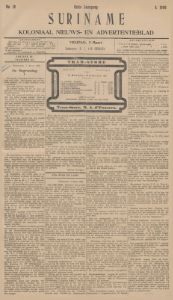About the day » Friday March 5, 1909Calender converter
Born on Friday March 5, 1909
- Aagje van der Meije, Zandvoort († 2001)
- Anna Cornelia KERSTENS, Etten-Leur,Noord-Brabant,NEDERLAND
- Anna Catharina Van Gelder, Veerle († 1909)
- Adriana Cornelia Oprel, Rotterdam
- Anna Catharina Van Gelder, Veerle († 1909)
- Albert Steenbergen, Exloo Borger-Odoorn Drenthe Nederland
- (stillborn son) de JONG, Lekkerkerk (Z.-H.), Neth († 1909)
- Allegonda Wilhelmina Gerarda Hurk van den, Woensel, NB, Nederland († 1945)
- Adriana ALLEMEKINDERS, Kloetinge, Zeeland, Nederland († 1986)
- Agnes Maria Henriette Willekin, Aken (DL
Died on Friday March 5, 1909
- Adolphina Gesina Leuvens (59), Ginneken, Noord-Brabant, Netherlands
- Anna Elisabetha Kauwenberghs (66), Dessel,Antwerp,Belgium
- Alice Boyle (81), Altaglushan, Dungannon, Co. Tyrone, N. Ireland
- Albert Jan Hartman (69), het Schut B242, Hoogeveen, Drenthe, Netherlands
- Albertus Willem Marinus Vermeer (0), Arnhem
- Alphonsius Joseph HOUBEN (1), Boorsheim,Provincie Limburg,Flanders,Belgie
- Adelaide Persoons (81), Mariastraat C44, Brugge
- Albert Jans Hartman (69), Hoogeveen Drenthe, Netherlands(Schut)
- Albert Jan van Werven (68), Vorchten (Gem. Heerde)
- Albert Jan HARTMAN (69), Schut (Hoogeveen), Drenthe, Nederland
Source: Delpher (KB | national library) Newspapers from March 5, 1909 at Delpher
Born on March 5
- 1904 » Karl Rahner, German priest and theologian († 1984)
- 1905 » László Benedek, Hungarian-American director and cinematographer († 1992)
- 1908 » Fritz Fischer, German historian and author († 1999)
- 1908 » Irving Fiske, American author and playwright († 1990)
- 1908 » Rex Harrison, English actor († 1990)
- 1910 » Ennio Flaiano, Italian author, screenwriter, and critic († 1972)
- 1910 » Momofuku Ando, Taiwanese-Japanese businessman, founded Nissin Foods († 2007)
- 1912 » Jack Marshall, New Zealand colonel, lawyer, and politician, 28th Prime Minister of New Zealand († 1988)
- 1915 » Henry Hicks, Canadian academic and politician, 16th Premier of Nova Scotia († 1990)
- 1915 » Laurent Schwartz, French mathematician and academic († 2002)
Died on March 5
- 1893 » Hippolyte Taine, French historian and critic (b. 1828)
- 1895 » Nikolai Leskov, Russian author, playwright, and journalist (b. 1831)
- 1895 » Sir Henry Rawlinson, 1st Baronet, English general and scholar (b. 1810)
- 1907 » Friedrich Blass, German philologist, scholar, and academic (b. 1843)
- 1925 » Johan Jensen, Danish mathematician and engineer (b. 1859)
- 1927 » Franz Mertens, Polish-Austrian mathematician and academic (b. 1840)
- 1929 » David Dunbar Buick, Scottish-American businessman, founded Buick (b. 1854)
- 1934 » Reşit Galip, Turkish academic and politician, 6th Turkish Minister of National Education (b. 1893)
- 1935 » Roque Ruaño, Spanish priest and engineer (b. 1877)
- 1940 » Cai Yuanpei, Chinese philosopher and academic (b. 1868)
Names that were popular for boys in 1909
Names that were popular for girls in 1909
Source: Wikipedia Historical events 1909
- Koningin Wilhelmina (Huis van Oranje-Nassau) was from 1890 till 1948 sovereign of the Netherlands (also known as Koninkrijk der Nederlanden)
- In The Netherlands , there was from February 12, 1908 to August 29, 1913 the cabinet Heemskerk, with Mr. Th. Heemskerk (AR) as prime minister.
- The Netherlands had about 5.8 million citizens.
- January 23 » RMSRepublic, a passenger ship of the White Star Line, becomes the first ship to use the CQD distress signal after colliding with another ship, the SS Florida, off the Massachusetts coastline, an event that kills six people. The Republic sinks the next day.
- February 22 » The sixteen battleships of the Great White Fleet, led by USSConnecticut, return to the United States after a voyage around the world.
- February 26 » Kinemacolor, the first successful color motion picture process, is first shown to the general public at the Palace Theatre in London.
- March 4 » U.S. President William Taft used what became known as a Saxbe fix, a mechanism to avoid the restriction of the U.S. Constitution's Ineligibility Clause, to appoint Philander C. Knox as U.S. Secretary of State.
- March 23 » Theodore Roosevelt leaves New York for a post-presidency safari in Africa. The trip is sponsored by the Smithsonian Institution and National Geographic Society.
- September 23 » The novel Le Fantôme de l'Opéra (The Phantom of the Opera), by Gaston Leroux, is published as a serialization in Le Gaulois.
Weather March 5, 1909
The temperature on March 5, 1909 was between -9.4 °C and 1.8 °C and averaged -2.7 °C. There was 0.2 mm of rain. There was 5.6 hours of sunshine (50%). The average windspeed was 3 Bft (moderate breeze) and was prevailing from the south-southwest.

 March 4, 1909
March 4, 1909